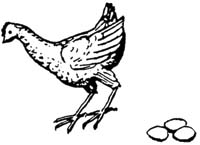14.1.3 Eating well with little money
The biggest cause of poor nutrition is poverty. A very poor family can eat better by spending money wisely and not wasting what little they have. A father who buys alcohol, tobacco and ‘chat’ (or khat) could instead buy nutritious food or he could buy a hen to lay eggs. A mother who buys her children sweets or soda pop could instead buy eggs, beans or other low-cost, healthful foods. Here are some ideas that families can use to eat better with little money.

Beans, peas and lentils
Beans, peas and lentils belong to a family of vegetables called legumes. All legumes have a lot of protein and vitamins, and they usually do not cost much. They have even more vitamins if they are sprouted before being eaten. Planting legumes makes soil richer. Other crops such as maize will grow better in a field where legumes once grew (Figure 14.2).

Less expensive meats and animal products
Blood and organ meats like liver, heart and kidney have a lot of iron and may cost less than other meats. Fish and chicken are as healthy as other meats, and usually cost less — especially for a family that fishes or raises their own chickens. Eggs have a lot of protein, iron, and vitamin A. Eggs give more protein for less money than almost any other food.
Whole grains
Grains like teff, wheat, rice and corn are more nutritious when they have not been refined (processed to take out the colour). Taking out the colour takes out healthy things too. White bread and white rice have fewer vitamins, minerals and proteins than brown bread or brown rice. Dark teff and brown injera are more nutritious than the light-coloured ones.
Vegetables and fruits

When vegetables are boiled or steamed, some of the vitamins from the foods go into the cooking water. Use this water to make soups.
The outside leaves of plants are usually thrown away, but sometimes they can be eaten. The leaves of the cassava plant have more vitamins and protein than the root. Many wild fruits and berries are rich in vitamins and natural sugars that give energy.
Breast milk
Breast milk costs nothing, and has all the nutrition a baby or young child needs. Young children who are on exclusive breastfeeding do not need fortified milks or other foods until after the age of 6 months.
14.1.2 Talking to women about food
